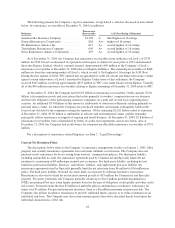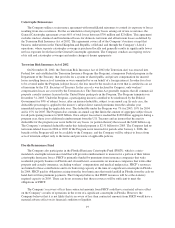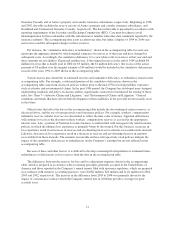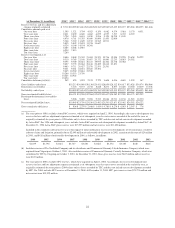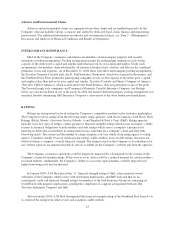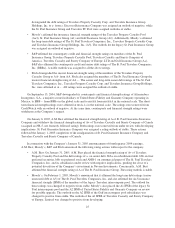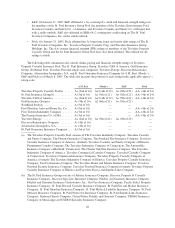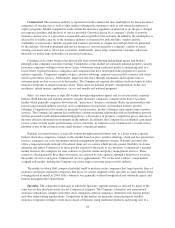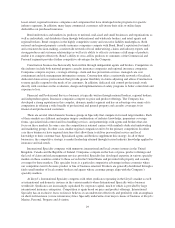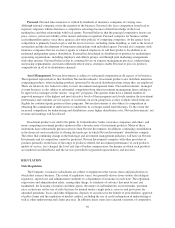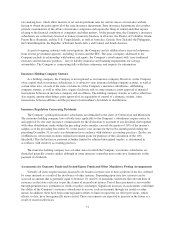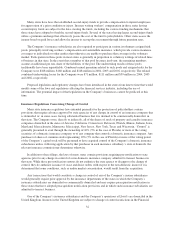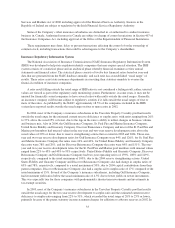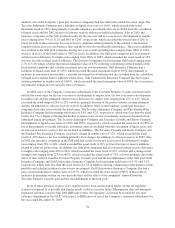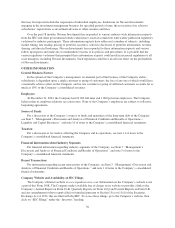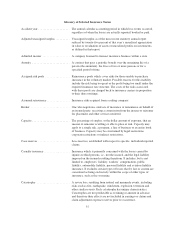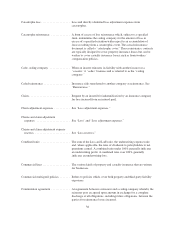Travelers 2004 Annual Report Download - page 40
Download and view the complete annual report
Please find page 40 of the 2004 Travelers annual report below. You can navigate through the pages in the report by either clicking on the pages listed below, or by using the keyword search tool below to find specific information within the annual report.Commercial. The insurance industry is represented in the commercial lines marketplace by many insurance
companies of varying size as well as other entities offering risk alternatives such as self-insured retentions or
captive programs. Market competition works within the insurance regulatory framework to set the price charged
for insurance products and the level of service provided. Growth is driven by a company’s ability to provide
insurance and services at a price that is reasonable and acceptable to the customer. In addition, the marketplace is
affected by available capacity of the insurance industry as measured by policyholders’ surplus and the
availability of reinsurance. Surplus expands and contracts primarily in conjunction with profit levels generated
by the industry. Growth in premium and service business is also measured by a company’s ability to retain
existing customers and to attract new customers. Additionally, many large commercial customers self-insure
their risks or utilize large deductibles on purchased insurance.
Commercial Accounts business has historically been written through independent agents and brokers,
although some companies use direct writing. Competitors in this market are primarily national property casualty
insurance companies willing to write most classes of business using traditional products and pricing and, to a
lesser extent, regional insurance companies and companies that have developed niche programs for specific
industry segments. Companies compete on price, product offerings, response time in policy issuance and claim
and loss prevention services. Additionally, improved efficiency through automation and response time to
customer needs are key to success in this market. The Commercial segment also utilizes dedicated units to tailor
insurance programs to unique insurance needs. These units are national property, transportation, boiler and
machinery, inland marine, agribusiness, excess and surplus and national programs.
Select Accounts business is typically written through independent agents and, to a lesser extent, regional
brokers. Both national and regional property casualty insurance companies compete in the Select Accounts
market which generally comprises lower hazard, “main street” business customers. Risks are underwritten and
priced using standard industry practices and a combination of proprietary and standard industry product
offerings. Competition in this market is primarily based on price, product offerings and response time in policy
services. The Commercial segment has established a strong marketing relationship with its distribution network
and has provided it with defined underwriting policies, a broad array of products, competitive prices and one of
the most efficient automated environments in the industry. In addition, the Company has established centralized
service centers to help agents perform many service functions, in return for a fee. Commercial’s overall service
platform is one of the strongest in the small business commercial market.
National Accounts business is typically written through national brokers and, to a lesser extent, regional
brokers. Insurance companies compete in this market based on price, product offerings, claim and loss prevention
services, managed care cost containment and risk management information systems. National Accounts also
offers a large nationwide network of localized claim service centers which provide greater flexibility in claims
adjusting and allows Commercial to more quickly respond to the needs of its customers. Commercial’s residual
market business also competes for state contracts to provide claims and policy management services. These
contracts, which generally have three-year terms, are selected by state agencies through a bid process based on
the quality of service and price. Commercial services approximately 35% of the total workers’ compensation
assigned risk market, making the Company one of the largest servicing insurers in the industry.
The market in which Gulf competed included small to mid-size niche companies that target specific lines of
insurance and larger, multi-line companies that focus on various segments of the specialty accounts market. Prior
to being placed in runoff in 2004, Gulf’s business was generally written through retail and wholesale agents and
brokers throughout the United States.
Specialty. The competitive landscape in which the Specialty segment operates is affected by many of the
same factors described previously for the Commercial segment. The Company’s domestic and international
insurance subsidiaries compete with other stock companies, mutual companies, alternative risk sharing groups
and other underwriting organizations. Competitors in this market are primarily national property-liability
insurance companies willing to write most classes of business using traditional products and pricing and, to a
28


